#charles starkweather
Text
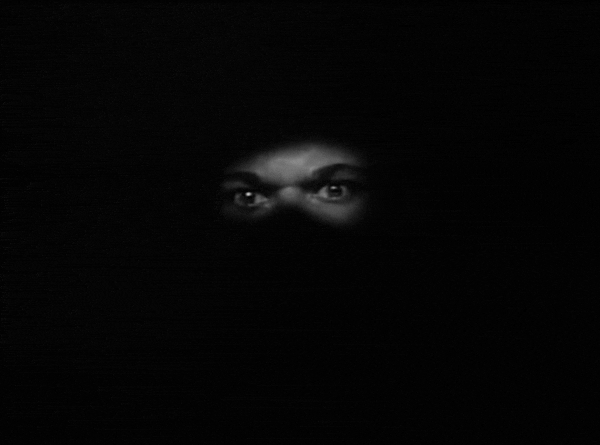
The Sadist | 1963 — aka Sweet Baby Charlie
Arch Hall Jr. is great as the nasty psycho Charlie
#Arch Hall Jr.#James Landis#The Sadist#Charles Starkweather#eyes#horror#typography#movie titles#film titles#hammersmith horror
125 notes
·
View notes
Text




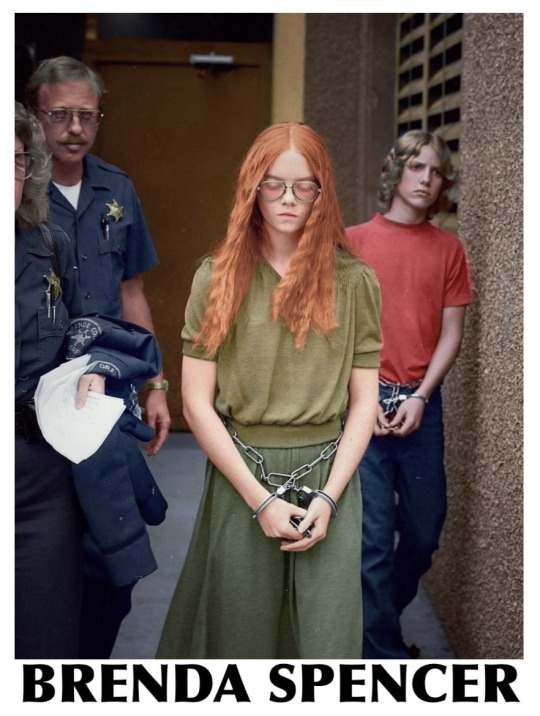

Songs About Murderers
)c(
#true crime#serial killers#criminal investigations#crime after crime#psycho killer#murder ballads#songs about serial killers#john wayne gacy#true story#Charles Starkweather#Rose West#albert desalvo#boston strangler#spree killer#Neko case#bruce springsteen#interpol#Rolling stones#sufjan stevens#brenda spencer#the boomtown rats#Spotify
7 notes
·
View notes
Text
90: Joe Coleman // Infernal Machine
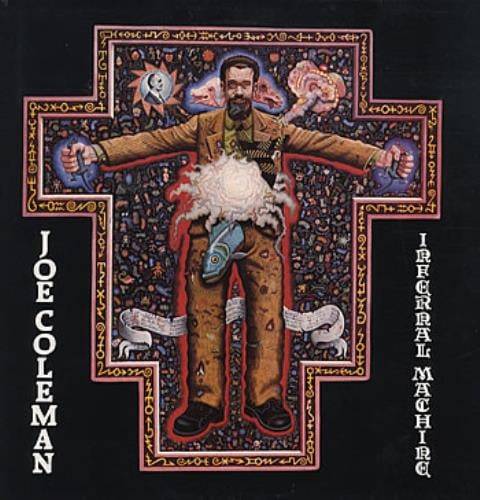
Infernal Machine
Joe Coleman
1990, Blast First
Joe Coleman emerged in the late 1970s from the alternative comix scene established by artists like Art Spiegelman (Maus), Kim Deitch (Waldo the Cat), and Bill Griffith (Zippy the Pinhead), but found greater notoriety as a painter and a shock artist. Here’s Spin’s Dean Kuipers on a performance (as his character Professor Mombooze-o) that resulted in one of Coleman’s numerous arrests:
“Boston, October 22, 1989. Reel after reel of ancient hardcore porno films flash onto a black screen onstage at BF/VF—the Boston Film/Video Foundation—grey and grainy, somebody else's fucking and sucking memories of indeterminate age. After 20 minutes, the hundred people in the audience are quiet and disarmed. The lights come up.
Joe Coleman instantly comes whapping through the film screen from behind, hanging upside down from a climber's harness attached to the ceiling, screaming and choking like a man condemned. This is the man everyone came to see. Green flames and acrid smoke belch from his chest as strapped-on explosives detonate under layers of shirt, ratty duck jacket and lab coat. Half a minute later, the booming and gnarling subside and Coleman's wife, Nancy, leaps out and douses him with goats’ blood to put out the fires. She cuts him down and he tears away what's left of the black screen to reveal a dead goat hanging upside down, twisting slowly. The goat is real. The odor of spattered blood and gunpowder seeps into the stunned crowd.
'Here are Mommy and Daddy!' cries Coleman, rushing to the front of the stage and pulling two live white mice from his pockets. He sits down on the edge of the stage and holds Mommy and Daddy up to his scorched beard and talks to them. Meanwhile, Nancy pulls out her Zippo and torches a cloth/plastic effigy of Coleman. The stage is consumed by fire as Joe screams at the squirming mice, 'I'll eat the cancer out of you!' and bites the head off Daddy, spewing it back into the audience. Then he snaps Mommy's head: hers he swallows.
This is Joe Coleman's stone ritualization of his mother's death. Four days earlier, she had died of cancer.
The befuddled firemen who arrive minutes later are sure that this must be the meeting of a satanic cult. As police investigators pick through the chaos of greening humans, brown smoke and bloody carcasses, the owners of BF/VF finger Joe and Nancy, then fire manager Jeri Rossi. All three are arrested and Joe is charged with—among other things—an old Massachusetts blue law charge that hasn't been used since the 1800s: Possession of an Infernal Machine."
(You can watch an excerpt of a similar performance in the 1988 pseudo-documentary Mondo New York, though I do not recommend doing so if you’re troubled by animal cruelty.)
The Infernal Machine LP is a figurative soundtrack to the Mombooze-o character, which he retired following the Boston bloodbath. Side one (“Homage to Mass Murderers”) intersperses vintage country and blues murder ballads with exploitation film clips and interviews with murderers Ed Kemper and Charles Manson. Side two (“Infernal Machine”) is a collage of clips from TV shows and ‘40s films noir, audio from Coleman’s Mondo New York performance, and early live recordings by NYC noise punks Steel Tips.
youtube
The overall effect is eerie, and there are some powerful juxtapositions. The way the clip of Kemper’s tearful description of murdering his own mother segues into Eddie Noack’s 1968 recording of “Psycho” underscores the song’s unnerving potency; tucked between relatively jaunty tunes by Bessie Smith and Tex Ritter, a long clip of character actor Don Russell’s genuinely moving performance as a kidnapped schoolteacher begging for his life from 1963’s The Sadist (based on the Charles Starkweather murders) seems to represent man’s powerlessness in a capricious universe. Side two is bookended by excerpts from the 1947 film Nightmare Alley, in which a series of disasters reduce cocksure Stan Carlisle (played by Tyrone Power) from his position as a carnival barker to the role of a despised geek who earns a meagre living by biting the heads off chickens in front of jeering crowds. The implication is that, as Mombooze-o, Coleman himself has been similarly forced into the role of a freak by the diseased contemporary world.
The LP includes a twelve-page booklet of Coleman’s paintings and, most interestingly, a picture-disc reproduction of details from its cover image, Portrait of Professor Mombooze-o. I’m not normally much interested in picture discs, but the sight of Coleman’s zombified head spinning on the table (or the dead fish bursting from his crotch on the flip) really does complete the package. It’s as a visual artist that Coleman’s chief gifts reveal themselves. His obsessively detailed paintings, which he works out over months and sometimes years using a single horsehair brush, are the most successful transference of an alt. comix sensibility to the gallery I’ve come across. If the work in R. Crumb’s classic Weirdo anthologies could feel like a mutated, devolved descendent of the feverish iconography of sixteenth century religious art, Coleman’s paintings are that mutant culture’s return to high art.
Coleman frequently conflates people like Charles Manson with Jesus Christ, saying in a ‘90s tour of his collection of oddities that he keeps a lock of Manson’s hair and a sample of Christ’s marrow. Falling back on the Blakean idea of a marriage of heaven and hell, he claims that if the pair’s DNA could be mixed in a clone it would create a perfect Messiah. However, the mingling of deviants and prophets in Coleman’s hagiographic art does not, as Coleman seems to mystically intend, elevate the former towards divinity so much as it pulls the latter earthward. Serial killers are, almost without exception, insipid creatures, powerless to explain their own behaviour with any real insight—as are for that matter, many holy men. Maniacs and religious figures are akin in the sense that each possesses intense evocative potential. A crazed killer’s actions, which seem both primal and alien, tear at the fabric of our notion of a shared reality. It is tempting to read their murders, being as superficially inexplicable as miraculous events, as signs or portents, the killers themselves as visionaries. Put another way, both religious phenomena and psychopathic behaviour create a void of ostensible meaning that humans are agitated to fill. Meaning does not arise from their actions but is imputed to them by witnesses. In Coleman, these boring, broken men who kill find a witness capable of making them a genuinely mythic force.
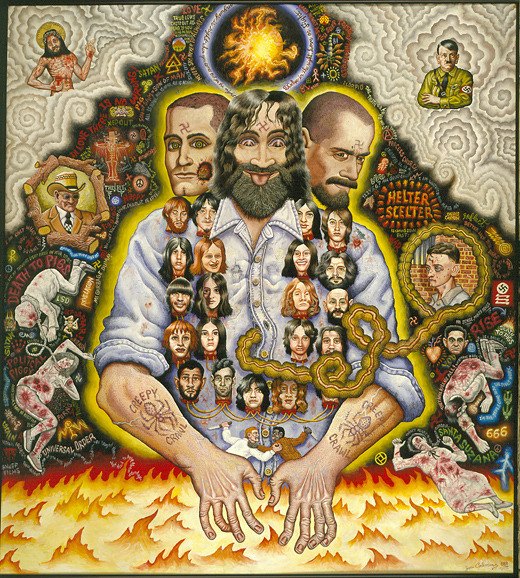
Portrait of Charles Manson, 1988
I find Coleman’s art as inspired and fascinating as I find his philosophy stunted and dull. In an interview with Richard Metzger on the BBC series Disinformation, Coleman says, with reference to mass murderer Richard Speck, “I don't want to kill anybody, but I want to express that pain. I want to express what he was trying to express. What if he didn't have to do that? And maybe, just maybe, art is a thing where you can do that.” Ten years previously, Coleman told an anecdote in Mondo New York about covering himself in blood and harassing random women at New York bars; when their boyfriends would intervene, he’d light the fuse on the hidden explosives attached to his chest and then calmly walk out of the bar in the confusion, enjoying the screams and smoke. Whether he’s spinning a yarn or recounting something he actually did, it’s clear he gets the same petty thrill out of terrifying strangers as the sickos (both real and fictional) excerpted on the Infernal Machine LP do. This doesn’t make him a monster, but it does clarify that when he talks about “expressing” their pain he also wants his share of their freedom to do violence. Of all the reasons it’s good for Coleman that he ended up an artist instead of a cut-rate David Berkowitz, the most telling is this: if he had, what artist of his quality would’ve wanted to take him as their subject?
90/365
#joe coleman#vinyl record#music review#picture disc#serial killers#charles starkweather#charles manson#manson family#richard speck#richard metzger#nightmare alley#alt. comix#comix#weirdo#mondo#'80s music#'50s music#'40s music#'60s music#'70s music
4 notes
·
View notes
Text
““I got some stuff to say,” Kit says to Holly, in the first few minutes of Terrence Malick’s Badlands. “Guess I’m kinda lucky that way.” Released 50 years ago, Badlands is the violent, compulsive opening of Malick’s singular moviemaking life; he has spent that life directing films that demand seeing and re-seeing. For his part, Martin Sheen, who played Kit, describes the Malick effect for those fortunate enough to be susceptible to it as “a certain kind of lyricism that just strikes some deep part of you and that you hold on to.” For this reason, writing about any Malick film is strangely awkward. You feel his suspicion of having “some stuff to say.”
The director turns 80 this year. From the 1950s desert of Badlands to the 1916 Texas panhandle in Days of Heaven toward a culmination of sorts in 2005’s The New World—which makes the 1607 English arrival in Virginia and the romance of John Smith and Pocahontas into a tragic foundational myth—his films are both universal and wholly American. His debut starred Martin Sheen and Sissy Spacek as Kit and Holly, a young couple on a desperate, murderous ride across the Midwest.
For almost as long as he has been making films, Malick has largely avoided public appearances or interviews. In the couple of years after Badlands’ release, however, he did give a couple, and from these can be gleaned the reasons for his self-recusal. Theorizing and writing about such work as he creates (to use his own words from 1974) “just comes out sounding like a theory.” His film aesthetic is inseparable from his ethic, from a worldview. Almost uniquely in cinema, each of his films is in fact a worldview. They are in a sense complete and contained in themselves.
In the interviews around Badlands, Malick was asked about his aspirations for his work. He replied always along the lines of “setting a mood” or “setting a tone.” Perceiving the world takes primacy over narrative: color, movement, contrast, montage, sequence, objects and things, animals, and people; appearances, sounds, music. The ceaseless possibility of interweaving all these things to allow an opening into what Malick called a “sense of things, of how the world falls.” There is place, not “setting.” Character rather than “character development.” Badlands shows that Malick knew from the very beginning the gift which cinema alone can offer.
(…)
Not that production was smooth. It seems that, even then, Malick inspired devotion in some and exasperation in others. Spacek remembered: “The shoot went on forever because people kept quitting. They were completely brutalized. They’d be setting up one shot over here, then Terry would look over in the other direction where the moon was rising up and he’d go, ‘Let’s shoot over there!’” Today, Malick’s reputation for spontaneity—rewriting his scripts as he shoots or changing plans on a whim in response to a new idea—is well-known. In the early 1970s, though, and still today, making a film in such a style was a trying endeavor. Malick ran through three cinematographers, several editors, sound, and other crew people. But, as Pressman noted, “Despite the input of these different hands,” the film “looks remarkably seamless. If the picture survived all those problems, it’s because one thing was consistent: Terry’s vision.”
The screenplay was based on a lurid true story of the late 1950s. Charles Starkweather, a blue collar 19-year-old, murdered the parents and infant sister of his under-age girlfriend, Caril Ann Fugate, and then fled with her across the Midwest on a spree that left ten more dead. Fugate was sentenced to life. She seems to have had some contact with Malick (who sympathized with her) around the film, during which time she was up for parole. Starkweather was sentenced to the electric chair.
The Starkweather case—and with it, the concept of “thrill murders”—triggered a national media campaign of panic. In Sheen’s words, it “affected [young people] on a very deep level. His image, his persona…he gave us an inside glimpse into the very worst part of ourselves. His character, his image of himself…in this country, we’re more interested in image than reality, and this guy is a reflection of that.” Starkweather, like Sheen’s Kit, modelled himself after that idol of his decade: James Dean.
(…)
In Malick’s interviews, a phrase that arises repeatedly is “fairy tale.” Though set in Eisenhower’s America of the 1950s, he wanted the film to appear “outside time.” A fairy tale “follows its own logic,” he said—just like Kit and Holly do. His lovers live in their own world, a world of images and self-images that trump reality. Many consider Badlands to be the story of “two psychopaths on the run,” as one documentary about Malick dubs it. But this judgment is a trap into which he invites us. He insisted that “I see no gulf between them and myself…What I find patronizing is people not leaving the characters alone, stacking the deck for them, not respecting their integrity, their difference.”
(…)
Malick's voiceovers never commit the sin of telling over showing; they are, instead, another dimension, a plane outside of, or beyond, the story as shown to us. Malick called Holly “a typical Southern girl in her desire to help, to give hard fact; not to dwell upon herself, which to her would be unseemly, but always to keep in mind the needs of others.” She is aware of herself as narrator, as a main character who “doesn’t really know her audience. It’s not that she’s simple-minded; she just thinks this is how she should talk when speaking to other people.”
She tells her story in the style of the glossy lifestyle magazines of the mid-50s, full of melodramatic romance: “He wanted to die with me, and I dreamed of being lost forever in his arms.” Or: “I sensed that my destiny now lay with Kit, and it was better to spend a week with one who loved me for what I was, than years of loneliness.” Or (my favorite): “It all goes to show how you can know a person and not really know him at the same time.”
Malick’s sympathies are usually with women, and in his vision of the inseparability of human and nature, his women are closer to nature (and the truth) because they are more “open.” The first thing we learn is that Holly has only ever known a man’s world, has never had a mother’s influence. Kit’s killing of her father (whose violent dominance is established early on when he shoots her dog as a punishment) is no liberation, just a transfer of power. Unlike the morally senseless Kit, Holly clearly feels the power of good and evil, right and wrong. But, in Malick’s words, “She just doesn’t know what to have moral feelings about.”
Malick is perceptive too of the ways that men turn women into icons rather than letting them be people—substitutes for the lacunae in themselves. If Holly’s voiceover speaks out of and into a kind of American deafness—to an audience that might judge her thoughts banal or irrelevant—then Kit is the film’s black hole, Malick’s challenge to the audience and to American manhood. He doesn’t know who he is nor what he wants; he doesn’t know why he’s killing people, and he can’t discover any reason to stop. He thinks of himself as some amalgam of American (male) archetypes: resourceful and ruthless frontiersman, outlaw, gunslinger, pioneer, rebel without a cause.
But the truth about figures like Kit is that they are, in truth, always reactionary—precisely because they view themselves as lone individuals, in opposition to the world. Malick likened Kit to “an Eisenhower conservative…a total supporter of the civic order.” “Listen to your parents or teachers,” Kit says, in one of the voice memos he feels compelled to leave to posterity. “They got an inside line in most things, so don’t treat them like enemies. Consider the minority opinion, but try to get along with the majority of opinion—once it’s accepted.” The one victim he chooses to spare is a rich man in whose house he and Holly briefly take refuge.
Malick told Sheen: "Think of that gun in your hand as a magic wand. Nothing serious, nothing personal. Someone gets in your way and—pouf—they’re gone. Disappeared.” Badlands is a fairy tale, and fairy tales are mythic. He did not want to be trapped within “50s nostalgia” but to say something about the substrate of America’s soul. It is a substrate made of violence, the true mythic foundation, the reason that the country came into being—something Malick later directly explored in The New World. For the early 70s, and still more today, Badlands is a complete, singularly pure encapsulation of American violence. When commentators speak of gun violence as an “epidemic,” it is a metaphor closer to reality than they often recognize. It is an epidemic that spreads by imitation—just as Kit and Starkweather thought that the way to become James Dean was to kill people.
In what is perhaps Badlands’ most famous shot, Kit stands silently looking out over vast Montana. The clouds drift across the sunset. The moon is coming out. The desert is glorious. Yet the landscape before him is mute and unattainable. He looks lost, his arms hooked helplessly over the rifle strung across his shoulders. The image has (surely intentional) echoes of a Crucifixion. He’s become a kind of human instantiation of America’s philosophy of violence—violence as self-actualization. “You’re quite an individual, Kit,” one of the cops says to him at the film’s close; Kit replies: “Think they’ll take that into consideration?” It’s hard to tell how seriously he means it.
In Malick’s own 1969 translation of Heidegger’s The Essence of Reasons, we read: “Freedom is the reason for reasons.” What we think of as freedom and the ability to make sense of, to find meaning in, to “reason” the world, are the same thing. Our freedom lies in our ability to create and destroy what we call “the world.” If God or Nature made The Earth, then humans make “the world.” The late philosopher Hubert Dreyfus, who taught Malick at Harvard and later taught courses on his cinema, had an elegantly simple definition: “The world is kind of the background of common sense, as to what it makes sense to do, and what it doesn’t make sense to do.”
Perhaps philosophy can’t be suitably written about film, but film can certainly perform a kind of philosophy. In The World Viewed, about the congruence of philosophy and film, Malick’s former professor, Stanley Cavell, asks: “To whom, from where, does one address a letter to the world? To what end does one wish to leave one’s mark upon the world?” This is one way of putting a question Badlands also asks. Holly addresses an unknowable audience. Kit, said Malick, “thinks he’s a character of incredible importance,” striving to leave some mark on the landscape. Bodies. Buried treasures. Finally, a pile of stones.”
#malick#terrence malick#badlands#martin sheen#sissy spacek#stark weather#charles starkweather#true crime#heidegger#martin heidegger#america#violence#gun violence
1 note
·
View note
Video
youtube
Bruce Springsteen - Nebraska (Lyrics) + Images
I remade this one after someone commented that the lyrics were hard to read on my original video due to them being colour-blind.
1 note
·
View note
Text
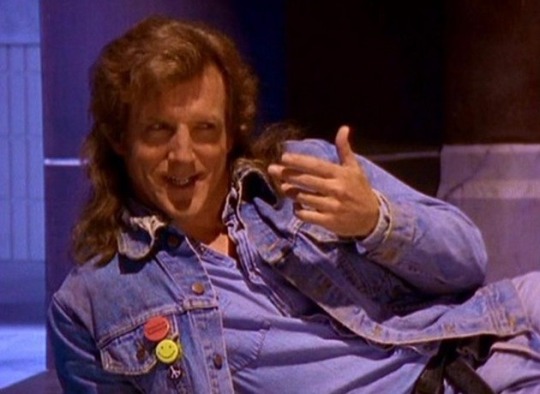

bro i just got knocked clean off my socks by a podcaster's description of a Stephen King character made in such a way that i finally, finally, understood the reference behind Uncle Wiley's character.
first, the stephen king wiki description on randall flagg:
Flagg is described as "an accomplished sorcerer and a devoted servant of the Outer Dark" with general supernatural abilities involving necromancy, prophecy, and unnatural influence over predatory animals and human behavior. His goals typically center on bringing down civilizations, usually through spreading destruction and sowing conflict.
huh! that sounds kind of familiar! alright, on with the podcast excerpt-
Randall Flagg, he's the dude we're all here for, in one way or another, right. Because… Just to let you know, if you're a listener who has not read a lot of Stephen King, if you're here because you like hearing us talk about it rather than reading it yourself, Randall Flagg is in some ways the lynchpin around which all of Stephen King's later work is going to be built upon. He's going to leave this novel and he's going to show up in other novels. Randall Flagg is the Walkin' Dude, and he walks a lot.
He is, uh- in- in the way that I think that if you're not a Stephen King reader, you probably associate Stephen King's ultimate embodiment of evil as Pennywise, because I think Pennywise has a much sharper popular culture profile. But Randall Flagg is really Stephen King's archvillain. And he is… He is the Heath Ledger Joker. He's also, kind of the Jared Leto Joker. He is also kind of the Jack Nicholson Joker! He is every Joker. Right? He's an Ur-Joker.
— It's very funny that you just said he's not Pennywise.
— Yeah. But he is the Joker!
— Yeah, yeah. He is an agent of chaos who is calculating.
— We get introduced to him - and I actually, I think the rest of the books kind of ruin Randall Flagg for me. Because Randall Flagg is really intriguing when we meet him here. He, uh, he's a drifter- so, again, we have these parallels. Nick Andrews, who is a drifter, but he's like, the good drifter… Randall Flagg is the bad drifter, who doesn't go from town to town to work, we get the sense that he just - he doesn't even remember his own past, right? There's something really weird about him right off the jump, he doesn't have a good sense of who he is and he does not care. He just has, like, weird memories of, like- impossible memories, right? Hhe remembers going to school with Charles Starkweather. He remembers riding with the KKK. He remembers, like, helping the weather underground build bombs. It's suggested that he's hanging out with Donald deFreeze and the SLA when they come up with the plan to kidnap Patty Hearst. And he's just a guy, he wears cowboy boots, he wears jeans, he wears a denim jacket, he's got pockets that are filled with all sorts of extremist literature? And, this is important- it's not just, like, extreme right-wing, right? It's extremism of any type. Right? Randall Flagg is the nightmare embodiment of horseshoe theory in a lot of ways.
—Yeah. We talked a lot about liberal centrist Stephen King, and I think it should be instructive to everyone that his ultimate villain is just extremism of any kind. Like, any political statement that- or any political belief that is, like, outside the Overton Window, that's Randall Flagg.
— He just, he has no ideology other than the sowing of chaos, right? Making everything worse is his goal and he doesn't have a very clear memory of his own life, the events are kind of strange, but also, and he has in his first chapter, right? He's walking down the highway and he always has- the phrase that is always used to describe him is that he "looks like a man with great good humor", right? He's always smiling, he's always laughing, but it's a mean and evil laugh.
from the Just King Things episode about The Stand.
i just feel so relieved because i've been kind of turning wiley's bizarre fucking sartorial choice of double denim in my head like a dog with a very confusing bone, but that decision is way less inscrutable if the source for the double denim turns out to be the bad-guy imaginary of Stephen King in the 70s sdkjskdjskdjskdj.
#starkid#team starkid#hatchetfield#uncle wiley#black friday musical#wilbur cross#was everyone onto this reference and it was just me who missed it because i never read the dark tower??#i was just listening to the podcast going hm alright so the stand is about a dualistic fight of good vs evil#and the devil stand-in is a dimension-traveling smug joker type who- wait what do you mean he wears denim#then i look at the wiki and of course that's game over because wiley just wears a 1:1 recreation of a randall flagg outfit smdskdjskdj#stephen king readers come to my rescue. what is up with this guy and how does uncle wiley compare and contrast
27 notes
·
View notes
Text
The Shadohunter Chronicles Character Showdown
First Round
Rosemary Herondale vs Arthur Blackthorn, (Feb 23)
Celine Montclaire vs Diego Rocio-Rosales, (Feb 24)
Maureen Brown vs Anna Lightwood, (Feb 25)
Christopher Lightwood vs Ragnor Fell, (Feb 26)
Julian Blackthorn vs Livvy Blackthorn, (Feb 27)
Bridget Daly vs Jon Cartwright, (Feb 28)
Nate Grey vs Sona Carstairs, (Feb 29)
Gabriel Lightwood vs Madeleine Bellefleur, (Mar 1)
Paige Ashdown vs Rupert Blackthorn, (Mar 2)
Valentine Morgenstern vs Kraig, (Mar 3)
Andrew Blackthorn vs Irene, (Mar 4)
Axel Mortmain vs Thais Pedroso, (Mar 5)
Kit Herondale vs Ke Yi Tian, (Mar 6)
The Dark Sisters vs Filomina di Angelo, (Mar 7)
Lucie Herondale vs Simon Lovelace-Lewis, (Mar 8)
Shiyun Jung vs Cameron Ashdown, (Mar 9)
Elias Carstairs vs Tavvy Blackthorn, (Mar 10)
Luke Greymark vs Will Herondale, (Mar 11)
Ash Morgenstern vs Matthew Fairchild, (Mar 12)
Sophie Collins vs Jaime Rocio-Rosales, (Mar 13)
Catarina Loss vs Tessa Grey, (Mar 14)
Jessamine Lovelace vs Woolsey Scott, (Mar 15)
Diana Wrayburn vs Magnus Lightwood-Bane, (Mar 16)
James Herondale vs Jesse Blackthorn, (Mar 17)
Sebastian Morgesnstern vs Ty Blackthorn, (Mar 18)
Julie Beavul vs Tatiana Lightwood, (Mar 19)
Meliorn vs Helen Blackthorn, (Mar 20)
Alexander Lightwood vs Arawn, (Mar 21)
Jace Lightwood-Herondale vs Michael Wayland, (Mar 22)
Raphael Santiago vs Kieran Kingson, (Mar 23)
Marisol Garza vs Hypatia Vex, (Mar 24)
Dru Blackthorn vs Ari Bridgstock, (Mar 25)
Eugenia Lightwood vs Bat Velasquez, (Mar 26)
Eliza Rosewain vs Rafael Lightwood-Bane, (Mar 27)
Anush Joshi vs Seelie Queen, (Mar 28)
Church vs Cecily Herondale, (Mar 29)
Annabel Blackthorn vs Robert Lightwood, (Mar 30)
Beatriz Mendoza vs Malcolm Fade, (Mar 31)
Jocelyn Fairchild vs Max Lightwood-Bane, (Apr 1)
Imogen Whitlaw vs Jem Carstairs, (Apr 2)
Mother Hawthorn vs Chairman Meow, (Apr 3)
Manuel Casales-Villalobos vs Barbra Lightwood, (Apr 4)
Cordelia Carstairs vs Benedict Lightwood, (Apr 5)
Divya Joshi vs Lily Chen, (Apr 6)
Patrick Penhallow vs Alastair Carstairs, (Apr 7)
Isabelle Lightwood vs Mark Blackthorn, (Apr 8)
Amatis Greymark vs George Lovelace, (Apr 9)
Maryse Lightwood vs Elliott, (Apr 10)
Alexei de Quincey vs Elyas the Demon, (Apr 11)
Hodge Starkweather vs Henry Branwell, (Apr 12)
Camille Belcourt vs Auraline, (Apr 13)
Aline Penhallow vs Roland Loss, (Apr 14)
Johny Rook vs Stephen Herondale, (Apr 15)
Rayan Maduabuchi vs Alec Lightwood-Bane, (Apr 16)
Esme Hardcastle vs Jordan Kyle, (Apr 17)
Grace Blackthorn vs Evelyn Highsmith, (Apr 18)
Jia Penhallow vs Charles Fairchild, (Apr 19)
Horace Dearborn vs Max Lightwood, (Apr 20)
Emma Carstairs vs Mina Carstairs, (Apr 21)
Charlotte Fairchild vs Aloysius Starkweather, (Apr 22)
Janus Herondale vs Zachary Carstairs, (Apr 23)
Gwyn ap Nudd vs Clary Fairchild, (Apr 24)
Maia Roberts vs Gideon Lightwood, (Apr 25)
Thomas Lightwood vs Cristina Mendoza-Rosales, (Apr 26)
#shadowhunters#the shadowhunter chronicles#tsc#the dark artifices#tda#the mortal instruments#tmi#the last hours#tlh#the wicked powers#twp#tid#the infernal devices#Shadowhunter Character Showdown 2024#Its back with more charcters then ever#*cries in a corner despiet knowing I brought this on myself*#I'll update with links as it goes along liek always
30 notes
·
View notes
Text

Fairuza Balk as Caril Ann Fugate, Brian Dennehy as John McArthur, Tim Roth as Charles Starkweather and Randy Quaid as Elmer Scheele in "Murder in the Heartland"
16 notes
·
View notes
Note
Can you be shackled with waist chains, and leg irons with a spit hood for hours? Also how long is someone allowed to stay in a straitjacket and can a spit hood be used while in a straitjacket thanks
You certainly can be shackled in that manner for hours! And you can certainly wear a spit hood with a straightjacket. The big question is how that works for you! When we apply any form of restraint, we immediately begin to subtly and audibly monitor you. We don't stand over you or ask you constant questions, but trust that we are always there.
Also, many guys have a, dare I say, inflated idea of what they can tolerate. That includes the guy typing this response. My first time prison role playing, I thought I was going to kick guard ass. I thought I was going to smuggle in handcuff keys. I thought I was going to be known as the love child of Lizzie Borden and Charles Starkweather (if you don't know who they are, then look them up!) The reality was that I was pretty weak and didn't last as long as I thought!

Question about Role Play Jail Restraints
33 notes
·
View notes
Note
Harry Truman 💼, Doris Day🌤, Red China🇨🇳, Johnnie Ray 🤷♀️
South Pacific💧, Walter Winchell👨🦲, Joe DiMaggio🐤
Joe McCarthy😰, Richard Nixon🏈, Studebaker🇺🇲, television📺
North Korea↖️, South Korea↘️, Marilyn Monroe👗
Rosenbergs🌹, H-bomb💣, Sugar Ray🦅, Panmunjom😗
Brando🙅♀️, "The King and I"👑, and "The Catcher in the Rye"🍞
Eisenhower👔, Vaccine🪡, England's got a new queen👸
Marciano✨️, Liberace🗽, Santayana👿, goodbye👋
We didn't start the fire🔥
It was always burning🔥, since the world's been turning🌎
We didn't start the fire🔥
No, we didn't light it🕯, but we tried to fight it👊
Joseph Stalin🫠, Malenkov🫢, Nasser and Prokofiev🫡
Rockefeller🫥, Campanella😶🌫️, Communist Bloc🫨
Roy Cohn🤠, Juan Peron🥳, Toscanini🥸, Dacron😥
Dien Bien Phu falls☺️, "Rock Around the Clock"⏰️
Einstein🦄, James Dean🎤, Brooklyn's got a winning team📣
Davy Crockett🤑, Peter Pan🧚♀️, Elvis Presley🔮, Disneyland🐭
Bardot😬, Budapest🧐, Alabama👬, Krushchev🥲
Princess Grace👑, Peyton Place⛳️, Trouble in the Suez 🤫
We didn't start the fire🔥
It was always burning🔥, since the world's been turning🌎
We didn't start the fire🔥
No, we didn't light it🕯, but we tried to fight it👊
Little Rock🪨, Pasternak🤐, Mickey Mantle🏌♂️, Kerouac🫤
Sputnik🥔, Chou En-Lai😔, "Bridge on the River Kwai"🤒
Lebanon🖖, Charles de Gaulle,✌️ California baseball⚾️
Starkweather homicide🗡, children of thalidomide🚸
Buddy Holly😇, Ben Hur,🫠 space monkey,🐒 mafia💸
Hula hoops🛖, Castro😀, Edsel is a no-go🙅♀️
U2🕺, Syngman Rhee🤖, Payola and Kennedy🙈
Chubby Checker🫣, Psycho🎻, Belgians in the Congo😒
We didn't start the fire🔥
It was always burning🔥, since the world's been turning🌎
We didn't start the fire🔥
No, we didn't light it🕯, but we tried to fight it👊
Hemingway, Eichmann😀, "Stranger in a Strange Land"😅
Dylan🤔, Berlin🅱️, Bay of Pigs invasion😴
"Lawrence of Arabia"🙄, British Beatlemania😬
Ole Miss😟, John Glenn,☹️ Liston beats Patterson🥹
Pope Paul✝️, Malcolm X😲, British politician sex😡
JFK – blown away😱, what else do I have to say?😫
We didn't start the fire🔥
It was always burning🔥, since the world's been turning🌎
We didn't start the fire🔥
No, we didn't light it🕯, but we tried to fight it👊
Birth control👶, Ho Chi Minh,🤭 Richard Nixon back again🫢
Moonshot🌔, Woodstock🦢, Watergate💧, punk rock🎸
Begin🤯, Reagan🧐, Palestine😦, terror on the airline😰
Ayatollah's in Iran😉, Russians in Afghanistan🥲
"Wheel of Fortune"🎡, Sally Ride😊, heavy metal suicide😮💨
Foreign debts🤕, homeless vets🫤, AIDS😦, crack😲, Bernie Goetz😯
Hypodermics on the shore😗, China's under martial law🫢
Rock and roller🎸, cola wars☕️, I can't take it anymore😫
We didn't start the fire🔥
It was always burning🔥, since the world's been turning🌎
We didn't start the fire🔥
But when we are gone💀
It will still burn on🔥, and on🔥, and on🔥, and on,🔥 and on🔥, and on🔥, and on🔥, and on🔥
We didn't start the fire🔥
It was always burning🕯, since the world's been turning🌎
We didn't start the fire🔥
No, we didn't light it,🕯 but we tried to fight it👊
We didn't start the fire🔥
It was always burning,🕯 since the world's been turning🌎
We didn't start the fire🔥
No, we didn't light it,🕯 but we tried to fight it👊
We didn't start the fire🔥
It was always burning🕯, since the world's been turning🌎
We didn't start the fire🔥
No, we didn't light it🕯, but we tried to fight it👊
Get the fuck outta my inbox
7 notes
·
View notes
Text
Some Rockstarverse headcanons
The book that Jack tells John about in RDR1 is about Red Harlow the book was written by a close ally of Red Harlow, Jack Swift
The book found in Franklin's condo in GTA 5 called Red Dead is the book written by Jack about the entire story of the Van Der Linde gang including what happened to Mary Beth Gaskill, Sadie Adler, Charles Smith, Reverend Swanson, Josiah Trelawney and Tilly Jackson by 1911
Eddie Low is actually the great nephew of Edmund Lowry Jr. and Eddie Low has been in quite a few snuff films directed by Lionel Starkweather and produced by Valiant Video Enterprise
Jimmy Hopkins is the son of James Earl Cash, Gary Smith is the younger brother of Leo Kasper and Petey Kowalski is the nephew of the journalist in Manhunt
Michael used to be a fan of Lionel Starkweather until he found out the depraved shit he did
Michael is also the nephew of Tommy Vercetti
Marshal Leigh Johnson is the grandfather of Cole Phelps
Trevor actually has met Mr. Nasty before and has starred in some snuff films Mr. Nasty himself says that Trevor could be the next James Earl Cash
The IAA has ties with The Pickman Project
Steve Haines is the great grandson of Edgar Ross
At Cole Phelps' funeral there was a man in a suit and top hat with a handle bar moustache nobody knew who he was though
Accounts of the same man have been spotted in Carcer City, Los Santos and Liberty City the man was also said to be in the town of Brimstone back in 1891 but nobody seems to know who this man is but it seems wherever there is death this strange man seems to follow
#grand theft auto 5#gta 5#grand theft auto vice city#gta vc#manhunt 2003#manhunt 2#red dead redemption 2#red dead redemption 1#red dead revolver#rdr2#rdr1#bully scholarship edition#la noire#l.a. noire#grand theft auto san andreas#gta sa#grand theft auto 4#gta 4#grand theft auto 3#gta 3
13 notes
·
View notes
Text

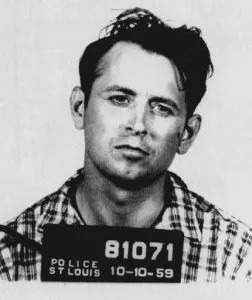


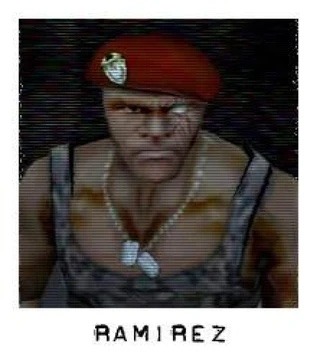

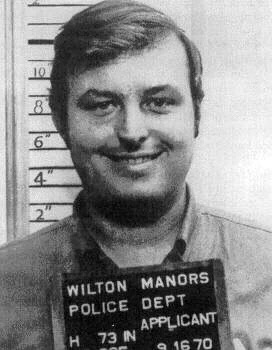

manhunt characters inspired by real life killers
james earl cash - james earl ray lionel starkweather - charles starkweather ramirez - richard ramirez gary shaffer - gerard shaefer
15 notes
·
View notes
Text

@arcanespillo thank you for this question!! Copied it to this account for collection purposes 😌
I do not have my desiccated finger on the pulse of what the popular Sam headcanons are these days lol BUT: Sam mostly likes salad and Celine Dion because he knows that those are things Dean will never like, so he can have them to himself. Sam doesn't have much to himself when it comes down to it, at all, in any space, so if arugula and It's All Coming Back to Me Now are where he can find some peace, so be it.
Sam's not actually that interested in serial killers; he's interested in spree killers who happen to be lovers. Like Leopold & Loeb, and Charles Starkweather & Caril Ann Fugate. Sam likes listening to Springsteen's Nebraska album in the car and Dean doesn't object, is complacent about it, although Dean always finds some reason to pop the tape out after Open All Night before it gets to the next song.
He's really really really into fucking women because most women seem very turned on by how big he is, and if they have any fear of him, it's the sexy kind. Dean is the only guy he sleeps with, more than once, anyway. (There was also Paul the bartender in that weird christian town but Sam doesn't want to think about that because he bottomed and it was very quiet and gentle and Paul really seemed to want to take care of Sam and he liked it so so much. Too much.)
9 notes
·
View notes
Text
Riverdale Characters Who Should've Appeared in the Final Season
Alan Mayberry
Anthony Topaz
Arthur Adams
Ms. Appleyard
Bernardo Bixby
Britta Beach
Brooke Rivers
Mrs. Burble
Carlos
Charles Smith
Chic
Chief Russell
Chuck Clayton
Coach Clayton
Commandant Carter
Darla Dickenson
Diana Whitley
Dodger Dickenson
Donna Sweett
Dreyfus Starkweather
Eddie
Elio Grande
Eric Jackson
FP, Glady and Jellybean Jones
Farmer McGinty
Ginger Lopez
Heather
Hermosa Lodge
Holden Honey
Howard Taylor
Janet Weiss
Jeffery and George Augustine
Jessica
Jillian Drake
Jonathan
KO Kelly
Katy Keene
Laurie Lake
Lerman Logan
Loudres Luna
Louis Cypher
Malachai
Marsha Lin
Marty Mantle
Moose and Marcus Mason
Malcolm Moore
Melody Valentine
Minerva Marble
Mad Dog
Mrs. Mulwray
Ms. Wright
Nana Topaz
Nancy Woods
Nick, Simone and Xander St. Clair
Oscar Castillo
Paul Sowerberry
Peaches 'N Cream
Penny Peabody
Rick
Ricky DeSantos
Sabrina Spellman
Samm Pansky
Sherry Winters
Sierra McCoy
Sister Woodhouse
Sweet Pea
Terry
Tina Patel
Toby
Trev Brown
Valerie Brown
Xandra Cabot
5 notes
·
View notes
Note
What’s the difference between serial killer + mass murderer + spree killer?
A serial killer is somebody who kills more than three people in different locations with a "cooling down" period between the murders. Jeffrey Dahmer, Edmund Kemper, and Ted Bundy were serial killers.
A mass murderer is someone who kills numerous people in a single incident in a single location. Nowadays these are most often mass shooters (Eric Harris and Dylan Klebold, Adam Lanza, Nikolas Cruz, etc) but they aren’t always (Richard Speck being an example of a mass murderer who strangled/stabbed his victims, or Timothy McVeigh who used a car bomb).
Spree killers (sometimes referred to as rampage killers) kill two or more victims at more than one location with no cooling off period. Charles Starkweather and Elliot Rodger were spree killers.
24 notes
·
View notes
Video
youtube
Billy Joel ~ We Didn't Start the Fire !!! (Official Video)
Harry Truman, Doris Day, Red China, Johnnie Ray
South Pacific, Walter Winchell, Joe DiMaggio
Joe McCarthy, Richard Nixon, Studebaker, Television
North Korea, South Korea, Marilyn Monroe
Rosenbergs, H-Bomb, Sugar Ray, Panmunjom
Brando, The King And I, and The Catcher In The Rye
Eisenhower, Vaccine, England's got a new queen
Marciano, Liberace, Santayana goodbye
We didn't start the fire
It was always burning
Since the world's been turning
We didn't start the fire
No, we didn't light it
But we tried to fight it
Joseph Stalin, Malenkov, Nasser and Prokofiev
Rockefeller, Campanella, Communist Bloc
Roy Cohn, Juan Peron, Toscanini, Dacron
Dien Bien Phu Falls, Rock Around the Clock
Einstein, James Dean, Brooklyn's got a winning team
Davy Crockett, Peter Pan, Elvis Presley, Disneyland
Bardot, Budapest, Alabama, Khrushchev
Princess Grace, Peyton Place, Trouble in the Suez
We didn't start the fire
It was always burning
Since the world's been turning
We didn't start the fire
No, we didn't light it
But we tried to fight it
Little Rock, Pasternak, Mickey Mantle, Kerouac
Sputnik, Chou En-Lai, Bridge On The River Kwai
Lebanon, Charles de Gaulle, California baseball
Starkweather Homicide, Children of Thalidomide...
Buddy Holly, Ben-Hur, Space Monkey, Mafia
Hula Hoops, Castro, Edsel is a no-go
U-2, Syngman Rhee, payola and Kennedy
Chubby Checker, Psycho, Belgians in the Congo
We didn't start the fire
It was always burning
Since the world's been turning
We didn't start the fire
No, we didn't light it
But we tried to fight it
Hemingway, Eichmann, Stranger in a Strange Land
Dylan, Berlin, Bay of Pigs invasion
Lawrence of Arabia, British Beatlemania
Ole Miss, John Glenn, Liston beats Patterson
Pope Paul, Malcolm X, British Politician Sex
J.F.K. blown away, what else do I have to say?
We didn't start the fire
It was always burning
Since the world's been turning
We didn't start the fire
No, we didn't light it
But we tried to fight it
Birth control, Ho Chi Minh, Richard Nixon back again
Moonshot, Woodstock, Watergate, punk rock
Begin, Reagan, Palestine, Terror on the airline
Ayatollah's in Iran, Russians in Afghanistan
Wheel of Fortune, Sally Ride, heavy metal, suicide
Foreign debts, homeless Vets, AIDS, Crack, Bernie Goetz
Hypodermics on the shores, China's under martial law
Rock and Roller Cola wars, I can't take it anymore
We didn't start the fire
It was always burning
Since the world's been turning
We didn't start the fire
But when we are gone
It will still burn on and on and on and on
And on and on and on and on...
We didn't start the fire
It was always burning
Since the world's been turning
We didn't start the fire
No, we didn't light it
But we tried to fight it
We didn't start the fire
It was always burning
Since the world's been turning
We didn't start the fire
No, we didn't light it
But we tried to fight it
We didn't start the fire
It was always burning
Since the world's been turning
We didn't start the fire
No, we didn't light it
But we tried to fight it
2 notes
·
View notes